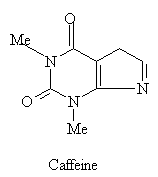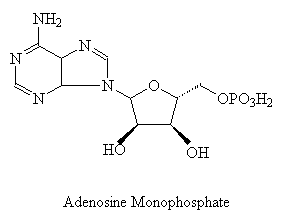

Caffeine was first isolated from green coffee beans in 1820. It was later found in tea, maté and cola nuts. The principal sources of the drug today are coffee and tea; these have a much higher concentration of caffeine than other sources like soft drinks, cocoa and chocolate, and coffee and tea account for approximately 90% of caffeine consumption. A 225 ml cup of tea (leaf or bag) contains 60 mg of caffeine. In comparison, a cup of ground roast coffee contains 125 mg per 225 ml. Tea actually contains more caffeine than coffee by dry weight but because more ground coffee than tea leaves are used to brew the drink in question, a cup of coffee contains a higher concentration of caffeine. More than 80% of the world's population consume caffeine daily; the average intake per day is between 200 and 400 mg.
At room temperature, it is a white odourless powder with a bitter taste. It is moderately soluble in water, but sufficiently hydrophobic to pass through biological membranes. Caffeine is a member of a family of purine derivative methylated xanthines. The purine ring system is commonly found in animals and plants and is a parent compound of some of the base constituents of the nucleotides that form RNA and DNA, the genetic blueprint for all living things.

After digestion, caffeine is rapidly and completely absorbed from the gastrointestinal tract into the blood stream. It is evenly spread though out the body; there is no evidence of it being concentrated in particular organs1. The presence of caffeine causes the translocation of intracellular calcium and increased levels of cyclic adenosine monophosphate (AMP), but this only occurs at levels beyond normal daily consumption. The principle chemical effect of typical caffeine usage is the blockage of adenosine receptors.

Caffeine and adenosine have a similar chemical structure and because of this, caffeine binds to the adenosine receptor in its place. However, since adenosine surpresses physiological activity, the blockage of adenosine receptors by caffeine produces a stimulant effect. The binding of adenosine causes drowsiness by slowing down nerve cell activity; this is why caffeine is used to prevent tiredness. Caffeine causes the brain's blood vessels to constrict because it inhibits adenosine's ability to open them up. This is why some headache tablets contain caffeine, because it will constrict the blood vessels and relieve it.
The usage of caffeine affects the biological functions of the body in several ways. Firstly, it is a central nervous system stimulant-it is a psychostimulant although studies have shown that its effects on electrical activity in the brain are modest2. It has sometimes been claimed that caffeine has effects on the autonomic nervous system that are similar to those of anxiety. However, whereas anxiety tends to increase heart rate and blood pressure, caffeine in moderate amounts increases blood pressure while generally having little effect on heart rate. Caffeine drinks also stimulate an increased flow of urine to a greater extent than non caffeinated drinks.
It is a commonly held belief that caffeine causes sleep disturbances
and this perception is supported by scientific findings. Studies suggest
that people with normal sleep patterns can develop insomnia by being given
caffeine close to bedtime3.

2. Bruce, M., Scott, N., Lader, M., Marks, V., The psychopharmacological and electrophysiological effects of single doses of caffeine in healthy human subjects, British Journal of Clinical Pharmacology, 22, 81-87, 1986
3. Bonnet, M. H., Arand, D. L. Caffeine use as a model of acute and chronic insomnia, Sleep, 15, 526-536, 1992
